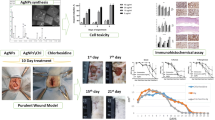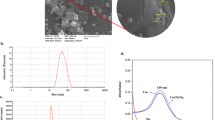Abstract
Bacterial biofilm formation and antibiotic resistance are the main factors of surgical wound complications. Traditional treatments in some cases cannot provide complete bacterial eradication and new therapeutic approaches should be developed to overcome antibiotic resistance. Silver nanoparticles (AgNPs) can be the first choice for bacteria treatment but their clinical application is limited due to toxic effects. Combination of AgNPs with the low-frequency ultrasound (US) treatment expected to decrease toxicity and leads to the facilitation of wound healing. In current research we investigated the antibacterial activity of AgNPs per se and in combination with low-frequency US, assessed the cytotoxicity of AgNPs on human dermal fibroblasts and finally, wound healing was evaluated in purulent wound model (96 white laboratory rats) applying AgNPs and US as a treatment strategy. Our results demonstrate no toxic effect of AgNPs in minimum inhibitory concentrations and show increasing their antibacterial effectiveness after US application. The combination of low-frequency US and AgNPs provides reduction of the inflammatory reaction, microorganism elimination and leads to facilitation of new tissue formation with complete epithelization. All effects were significant over the Chlorhexidine treatment, monotherapy with AgNPs or US. Advanced effectiveness of complex therapy opens new perspectives for clinical application of AgNPs solution accompanied by US.







Similar content being viewed by others
References
Merkow RP, Ju MH, Chung JW, Hall BL, Cohen ME, Williams MV, Tsai TC, Ko CY, Bilimoria KY. Underlying reasons associated with hospital readmission following surgery in the United States. JAMA. 2015;313(5):483–95.
Liu R, Chaudhary NS, Yealy DM, Huang DT, Wang HE. Emergency medical services care and sepsis trajectories. Prehosp Emerg Care. 2020;23:1–8.
Roy R, Tiwari M, Donelli G, Tiwari V. Strategies for combating bacterial biofilms: A focus on anti-biofilm agents and their mechanisms of action. Virulence. 2018;9(1):522–54.
Patini R, Mangino G, Martellacci L, Quaranta G, Masucci L, Gallenzi P. The effect of different antibiotic regimens on bacterial resistance: a systematic review. Antibiotics (Basel). 2020;9(1):E22.
Flemming HC, Wingender J. The biofilm matrix. Nat Rev Microbiol. 2010;8(9):623–33.
Franci G, Falanga A, Galdiero S, Palomba L, Rai M, Morelli G, Galdiero M. Silver nanoparticles as potential antibacterial agents. Molecules. 2015;20(5):8856–74.
Barshak MB, Durand ML. The role of infection and antibiotics in chronic rhinosinusitis. Laryngoscope Investig Otolaryngol. 2017;2(1):36–42.
Kalan LR, Brennan MB. The role of the microbiome in nonhealing diabetic wounds. Ann N Y Acad Sci. 2019;1435(1):79–92.
Driver VR, Blume PA. Evaluation of wound care and health-care use costs in patients with diabetic foot ulcers treated with negative pressure wound therapy versus advanced moist wound therapy. J Am Podiatr Med Assoc. 2014;104(4):147–53.
Daeschlein G. Antimicrobial and antiseptic strategies in wound management. Int Wound J. 2013;10(1):9–14.
Srinivas A, Kaman L, Raj P, Gautam V, Dahiya D, Singh G, Singh R, Medhi B. Comparison of the efficacy of chlorhexidine gluconate versus povidone iodine as preoperative skin preparation for the prevention of surgical site infections in clean-contaminated upper abdominal surgeries. Surg Today. 2015;45(11):1378–84.
Rodrigues AL, Simoes MdeL. Incidence of surgical site infection with pre-operative skin preparation using 10% polyvidone-iodine and 0.5% chlorhexidine-alcohol. Rev Col Bras Cir. 2013;40:443–8.
Wang L, Hu C, Shao L. The antimicrobial activity of nanoparticles: present situation and prospects for the future. Int J Nanomed. 2017;12:1227–49.
Cassano D, Mapanao A-K, Summa M, Vlamidis Y, Giannone G, Santi M, Guzzolino E, Pitto L, Poliseno L, Bertorelli R, Voliani V. Biosafety and Biokinetics of Noble Metals: The Impact of Their Chemical Nature. ACS Appl Bio Mater. 2019;2(10):4464–70.
Monteiro DR, Silva S, Negri M, Gorup LF, Camargo ER, Oliveira R, Barbosa DB, Henriques M. Silver colloidal nanoparticles: effect on matrix composition and structure of Candida albicans and Candida glabrata biofilms. J Appl Microbiol. 2013;114(4):1175–83.
Rai MK, Deshmukh SD, Ingle AP, Gade AK. Silver nanoparticles: the powerful nanoweapon against multidrug-resistant bacteria. J Appl Microbiol. 2012;112(5):841–52.
Panácek A, Smékalová M, Kilianová M, Prucek R, Bogdanová K, Věcěrová R, Kolár M, Havrdová M, Płaza GA, Chojniak J, Zbǒril R, Kvítek L. Strong and nonspecific synergistic antibacterial efficiency of antibiotics combined with silver nanoparticles at very low concentrations showing no cytotoxic effect. Molecules. 2016;21(1):1–17.
Toy LW, Macera L. Evidence-based review of silver dressing use on chronic wounds. J Am Acad Nurse Pract. 2011;23(4):183–92.
Conner-Kerr T, Alston G, Stovall A, Vernon T, Winter D, Meixner J, Grant K, Kute T. The effects of low-frequency ultrasound (35 kHz) on methicillin-resistant staphylococcus aureus (MRSA) in vitro. Ostomy Wound Manage. 2010;56(5):32–42.
Holubnycha V, Myronov P, Bugaiov V, Opanasyuk A, Dobrozhan O, Yanovska A, Pogorielov M, Kalinkevich O. Effect of ultrasound treatment on chitosan-silver nanoparticles antimicrobial activity. Conf Proc IEEE 8th International Conference on Nanomaterials: Applications and Properties. 2018; 04NNLS09–1–04NNLS09–4.
Hayashi D, Kawakami K, Ito K, Ishii K, Tanno H, Imai Y, Kanno E, Maruyama R, Shimokawa H, Tachi M. Low-energy extracorporeal shock wave therapy enhances skin wound healing in diabetic mice: a critical role of endothelial nitric oxide synthase. Wound Repair Regen. 2012;20(6):887–95.
Park HJ, Kim JY, Kim J. Silver-ion-mediated reactive oxygen species generation affecting bactericidal activity. Water Res. 2009;43(4):1027–32.
Tashi T, Vishal GN, Mbuya VB. Silver nanoparticles: Synthesis, mechanism of antimicrobial action, characterization, medical applications, and toxicity effects. J Chem Pharmaceut Res. 2016;8(2):526–37.
Yao K, Bae L, Yew WP. Post-operative wound management. Aust Fam Physician. 2013;42(12):867–70.
Burks RI. Ultrasound in wound care. Phys Ther. 2000;80(10):1015–7.
Thirumurugan G, Veni VS, Ramachandran S, Rao JV, Dhanaraju MD. Superior wound healing effect of topically delivered silver nanoparticle formulation using eco-friendly potato plant pathogenic fungus: synthesis and characterization. J Biomed Nanotechnol. 2011;7(5):659–66.
Prabhu S, Poulose E. Silver nanoparticles: mechanism of antimicrobial action, synthesis, medical applications, and toxicity effects. Int Nano Lett. 2012;2(32):32–41.
Driver VR, Yao M, Miller CJ. Noncontact low frequency ultrasound therapy in the treatment of chronic wounds: a meta-analysis. Wound Repair Regen. 2011;19(4):475–80.
Tian J, Wong KKY, Ho CM, Lok CN, Yu WY, Che CM, Chiu JF, Tam PKH. Topical delivery of silver nanoparticles promotes wound healing. Chem Med Chem. 2007;2(1):129–36.
Ulkür E, Oncul O, Karagoz H, Yeniz E, Celiköz B. Comparison of silver-coated dressing (Acticoat), chlorhexidine acetate 0.5% (Bactigrass), and fusidic acid 2% (Fucidin) for topical antibacterial effect in methicillin-resistant Staphylococci-contaminated, full-skin thickness rat burn wounds. Burns 2005;31(7):874–7.
Wright JB, Lam K, Buret AG, Olson ME, Burrell RE. Early healing events in a porcine model of contaminated wounds: effects of nanocrystalline silver on matrix metalloproteinases, cell apoptosis, and healing. Wound Repair Regen. 2002;10(3):141–51.
Heggers J, Goodheart RE, Washington J, McCoy L, Carino E, Dang T, Edgar P, Maness C, Chinkes D. Therapeutic efficacy of three silver dressings in an infected animal model. J Burn Care Rehabil. 2005;26(1):53–6.nn
Funding
This research was funded by EU-H2020-MSCA-RISE, Grant No 777926 NanoSurf. Bacteriology and cell culture research supported from Ministry of Education and Science of Ukraine Grants (0119U100823 and 0118U003577).
Author information
Authors and Affiliations
Corresponding author
Ethics declarations
Conflict of interest
The authors declare no conflict of interests
Ethical Approval
Keeping of the animals and experiments were carried in accordance with the Directive 2010/63/EU of the European Parliament and of the Council of 22 September 2010 on the Protection of Animals Used for Scientific Purposes. All the procedures performed in the study were approved by the Commission on Bioethics Compliance in Experimental and Clinical Research (Protocol #14/5, 09/11/2018). All experimental protocols using bacteria and cell cultures were approved by the Commission on Bioethics Compliance in Experimental and Clinical Research (Protocol #12/2, 07/09/2018).
Additional information
Publisher's Note
Springer Nature remains neutral with regard to jurisdictional claims in published maps and institutional affiliations.
Rights and permissions
About this article
Cite this article
Myronov, P., Bugaiov, V., Holubnycha, V. et al. Low-frequency ultrasound increase effectiveness of silver nanoparticles in a purulent wound model. Biomed. Eng. Lett. 10, 621–631 (2020). https://doi.org/10.1007/s13534-020-00174-5
Received:
Revised:
Accepted:
Published:
Issue Date:
DOI: https://doi.org/10.1007/s13534-020-00174-5




